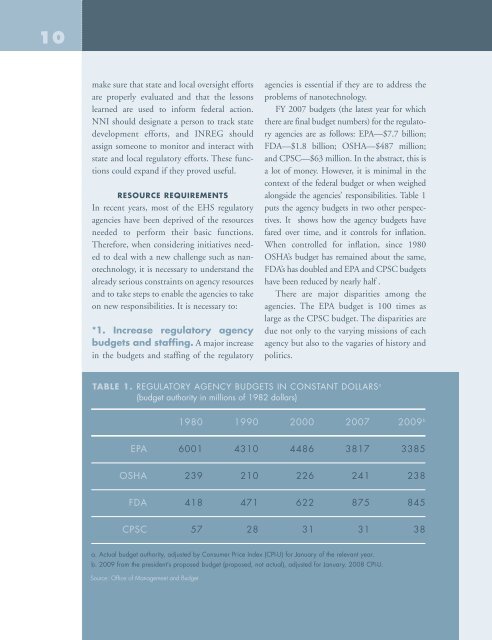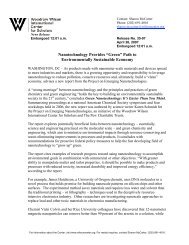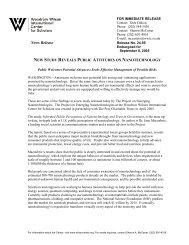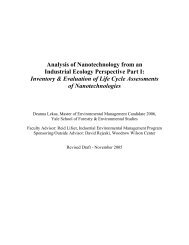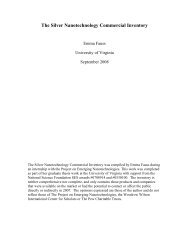nanotechnology oversight - Project on Emerging Nanotechnologies
nanotechnology oversight - Project on Emerging Nanotechnologies
nanotechnology oversight - Project on Emerging Nanotechnologies
You also want an ePaper? Increase the reach of your titles
YUMPU automatically turns print PDFs into web optimized ePapers that Google loves.
10<br />
make sure that state and local <str<strong>on</strong>g>oversight</str<strong>on</strong>g> efforts<br />
are properly evaluated and that the less<strong>on</strong>s<br />
learned are used to inform federal acti<strong>on</strong>.<br />
NNI should designate a pers<strong>on</strong> to track state<br />
development efforts, and INREG should<br />
assign some<strong>on</strong>e to m<strong>on</strong>itor and interact with<br />
state and local regulatory efforts. These functi<strong>on</strong>s<br />
could expand if they proved useful.<br />
RESOURCE REQUIREMENTS<br />
In recent years, most of the EHS regulatory<br />
agencies have been deprived of the resources<br />
needed to perform their basic functi<strong>on</strong>s.<br />
Therefore, when c<strong>on</strong>sidering initiatives needed<br />
to deal with a new challenge such as <str<strong>on</strong>g>nanotechnology</str<strong>on</strong>g>,<br />
it is necessary to understand the<br />
already serious c<strong>on</strong>straints <strong>on</strong> agency resources<br />
and to take steps to enable the agencies to take<br />
<strong>on</strong> new resp<strong>on</strong>sibilities. It is necessary to:<br />
*1. Increase regulatory agency<br />
budgets and staffing. A major increase<br />
in the budgets and staffing of the regulatory<br />
agencies is essential if they are to address the<br />
problems of <str<strong>on</strong>g>nanotechnology</str<strong>on</strong>g>.<br />
FY 2007 budgets (the latest year for which<br />
there are final budget numbers) for the regulatory<br />
agencies are as follows: EPA—$7.7 billi<strong>on</strong>;<br />
FDA—$1.8 billi<strong>on</strong>; OSHA—$487 milli<strong>on</strong>;<br />
and CPSC—$63 milli<strong>on</strong>. In the abstract, this is<br />
a lot of m<strong>on</strong>ey. However, it is minimal in the<br />
c<strong>on</strong>text of the federal budget or when weighed<br />
al<strong>on</strong>gside the agencies’ resp<strong>on</strong>sibilities. Table 1<br />
puts the agency budgets in two other perspectives.<br />
It shows how the agency budgets have<br />
fared over time, and it c<strong>on</strong>trols for inflati<strong>on</strong>.<br />
When c<strong>on</strong>trolled for inflati<strong>on</strong>, since 1980<br />
OSHA’s budget has remained about the same,<br />
FDA’s has doubled and EPA and CPSC budgets<br />
have been reduced by nearly half .<br />
There are major disparities am<strong>on</strong>g the<br />
agencies. The EPA budget is 100 times as<br />
large as the CPSC budget. The disparities are<br />
due not <strong>on</strong>ly to the varying missi<strong>on</strong>s of each<br />
agency but also to the vagaries of history and<br />
politics.<br />
TABLE 1. REGULATORY AGENCY BUDGETS IN CONSTANT DOLLARS a<br />
(budget authority in milli<strong>on</strong>s of 1982 dollars)<br />
1980 1990 2000 2007 2009 b<br />
EPA 6001 4310 4486 3817 3385<br />
OSHA 239 210 226 241 238<br />
FDA 418 471 622 875 845<br />
CPSC 57 28 31 31 38<br />
a. Actual budget authority, adjusted by C<strong>on</strong>sumer Price Index (CPI-U) for January of the relevant year.<br />
b. 2009 from the president’s proposed budget (proposed, not actual), adjusted for January. 2008 CPI-U.<br />
Source: Office of Management and Budget


